Anterior Triangle Of The Neck Questions With Answers
Platysma
It is a broad, flat muscle, remnant of the panniculus campus.
It lies superficial to the deep fascia of the neck.
Table of Contents
1 Proximal attachments are fascia over the
- Pectoralis major, and
- Deltoid.
| Body Fluids | Muscle Physiology | Digestive System |
| Endocrinology | Face Anatomy | Neck Anatomy |
| Lower Limb | Upper Limb | Nervous System |
Read And Learn More: Neck Anatomy Notes And Important Questions With Answers
2 Platysma Distal attachments: They are divided into anterior and posterior fibers
- Anterior fibers are inserted to the base of the mandible.
- Posterior fibers to the skin of the lower part of the face and lip.
3 Platysma Action: Depresses the skin It pulls the angle of the mouth downwards as in horror
4 Platysma Development: It is developed from the mesoderm of the 2nd pharyngeal arch hence supplied by the cervical branch of the facial nerve
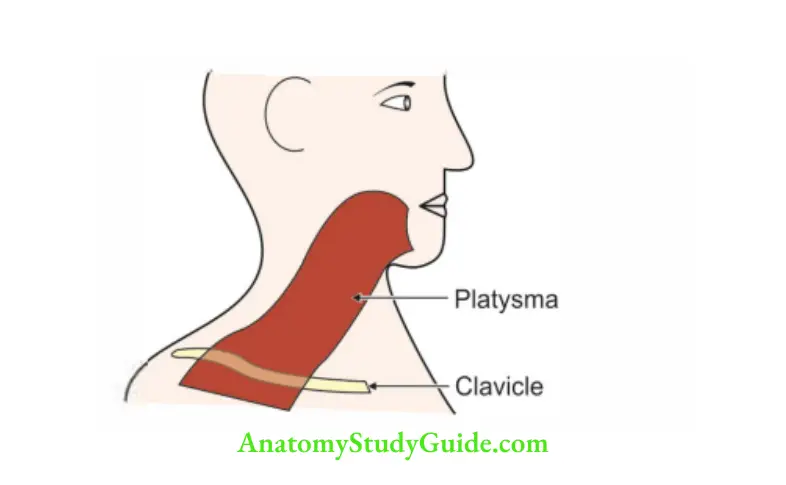
Muscular Triangle
1 Muscular Triangle Boundary
- Anteriorly: Anterior median line of the neck from the hyoid bone to the sternum.
- Posterosuperiorly: Superior belly of the omohyoid muscle.
- Posteroinferiorly: Anterior border of the sternocleidomastoid muscle.
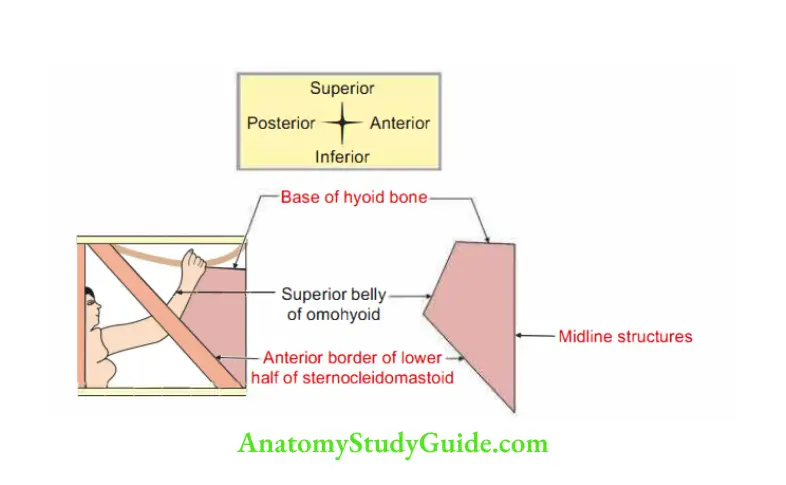
2 Muscular Triangle Contents: Infrahyoid muscles are the chief contents of the triangle These are
- Stemohyoid,
- Stemothyroid,
- Thyrohyoid, and
- Omohyoid.
Occipital Artery
Occipital Artery Introduction: It is the artery supplying the posterior aspect of the scalp It gives muscular branches to the sternocleidomastoid and stylohyoid
1 Occipital Artery Origin: It is the 1st dorsal branch of the external carotid artery arising opposite the facial artery. It emerges atoccipitalthe apex nerve of the posterior triangle of the neck It goes along with the greater occipital nerve.
2 Occipital Artery Course and Relations
- Courses deep to the lower border of the posterior belly of the digastric.
- Grooves the base of the skull at the occipitomastoid suture.
- Lies deep to the digastric notch.
3 Occipital Artery Peculiarities
- At its origin, it is crossed superficially by the hypoglossal nerve.
- Its upper branch acts as a guide to the accessory nerve.
- It has a tortuous course in the superficial fascia of the scalp.
4 Occipital Artery Branches
- Muscular branch to stylohyoid and sternocleidomastoid.
- Meningeal branch.
- Bonybranch to mastoid process.
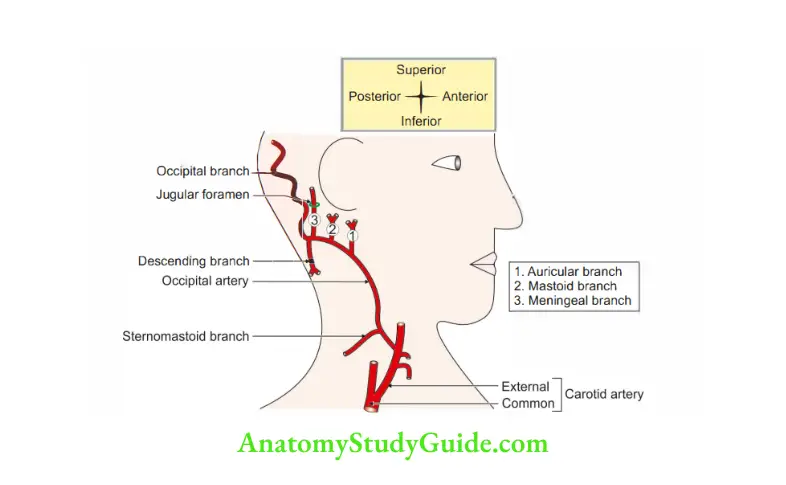
Question 1: Describe the digastric triangle under the following headings:
1 Digastric Triangle Boundaries,
2 Digastric Triangle Roof,
3 Digastric Triangle Floor,
4 Digastric Triangle Contents, and
5 Digastric Triangle Applied anatomy
Answer: 1 Digastric Triangle Boundaries
- Anteroinferior: Anterior belly of digastric
- Posteroinferior: Posterior belly of digastric and stylohyoid
- Superior (base) is by
- The base of the mandible, and
- Line joining the angle of the mandible to the mastoid process
2 Digastric Triangle Roof
Skin
Superficial fascia containing
- Cutaneous vein (tributaries of external jugular vein).
- Cutaneous branches of the great auricular nerve.
- Cervical branch of the facial nerve.
The deep fascia encloses the submandibular salivary gland.
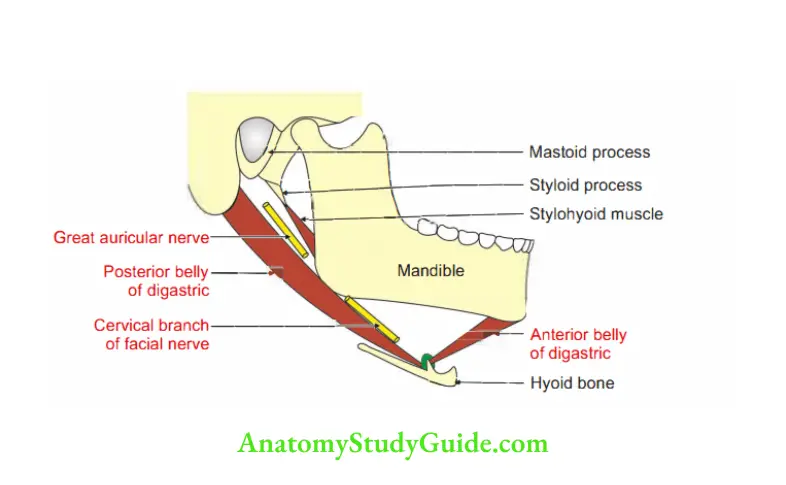
3 Digastric Triangle Floor: From anterior to posterior
- Hyoglossus,
- Mylohyoid, and
- Middle constrictor of the pharynx
4 Digastric Triangle Contents: They are grouped as structures in the
The anterior part of the triangle
Structures superficial to the mylohyoid are superficial parts of the submandibular gland
and related structures The relations can be visualized
- The submandibular gland hugs the mylohyoid by laying its major superficial part anteriorly and small deep part posteriorly.
- Semiflex your left wrist in such a way that the 4 fingers are placed anteriorly and the thumb posteriorly Tip of the fingers and thumb are referred to as the anterior ends of the superficial part of the submandibular gland.
- The number of fingers indicates the size of the gland.
- Four fingers of the left hand refer to the larger superficial part.
- The index finger of the left hand represents the facial vein.
- The middle finger of the left hand represents the mylohyoid vessels and nerve.
- The ring finger of the left hand represents submental vessels and nerves.
- The little finger of the left hand represents the submandibular lymph node, and
- The thumb of the left hand refers smaller deeper part Position of the wrist indicates that the superficial part of the gland is continuous with a deep part of the submandibular gland.
Posterior part of the triangle

5 Digastric Triangle Applied anatomy
Ludwig’s angina: It is a triangular swelling due to the infection of the submandibular region It is bounded
- Posteriorly by the hyoid bone, and
- Anterolaterally on each side by the two halves of the base of the mandible This is so because the investing layer of deep cervical fascia is attached to these bones
Collection of pus may push the tongue upwards
Digastric Muscle
Digastric Muscle Introduction: It is the suprahyoid muscle of the neck.
1 Digastric Muscle Origin: It has two bellies.
- Anterior belly arises from the digastric fossa of the mandible.
- The posterior belly arises from the digastric notch, present medial to the mastoid process.
2 Digastric Muscle Insertion: Both heads meet at the intermediate tendon which is held by a fibrous pulley attached to the hyoid bone.
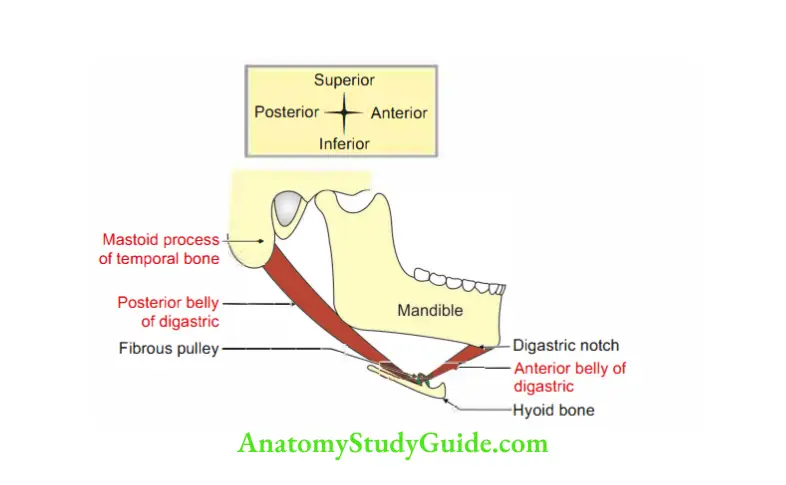
3 Digastric Muscle Nerve supply
- An Anterior belly is supplied by the nerve to the mylohyoid, a branch of the inferior alveolar nerve, a branch of the anterior division of the mandibular nerve.
- The posterior belly is supplied by the facial nerve.
4 Digastric Muscle Action
- It depresses the mandible when the mouth is opened widely.
- It elevates the hyoid bone.
5 Digastric Muscle Development
- The anterior belly develops from the mesenchyme of the first pharyngeal arch.
- The posterior belly develops from the mesenchyme of the second pharyngeal arch.
Question 2: Describe the Carotid Triangle under the following headings:
1 Carotid Triangle Boundaries,
2 Carotid Triangle Roof,
3 Carotid Triangle Floor,
4 Carotid Triangle Contents, and
5 Carotid Triangle Applied anatomy
Answer:1 Carotid Triangle Boundaries
Superiorly: Posterior belly of the digastric muscle and the stylohyoid.
Anteroinferiorly: Superior belly of the omohyoid.
Posteriorly: Anterior border of the upper half of the sternomastoid muscle.
2 Carotid Triangle Roof
Skin
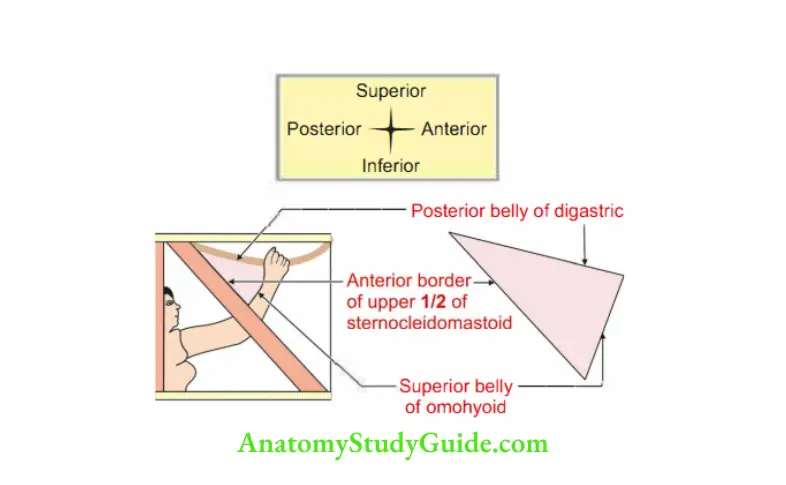
Superficial fascia It contains
- Platysma muscle,
- Cervical branch of the facial nerve, and
- The transverse cutaneous nerve of the neck
Investing layer of deep cervical fascia
3 Carotid Triangle Floor: It is formed by I Mi I
- Hyoglossus
- Inferior constrictors of the pharynx
- Throhyoid muscle
- Middle constrictor of the pharynx
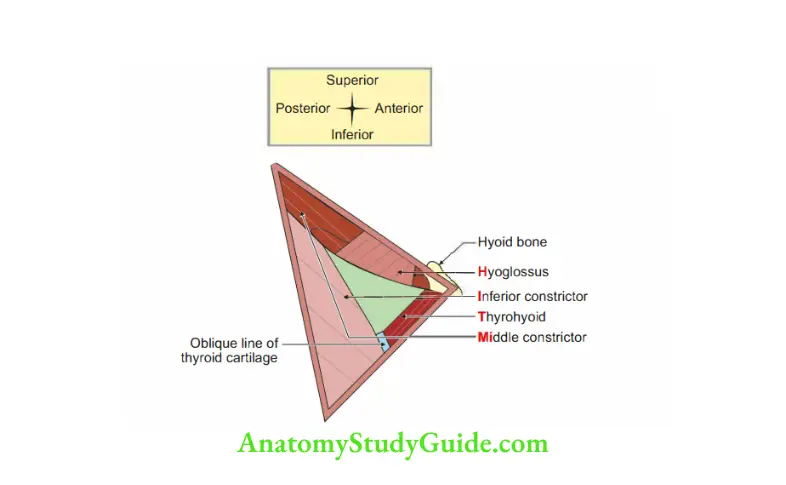
4 Carotid Triangle Contents
Carotid sheath
Contents
The common carotid artery and its two terminal branches
- Internal carotid artery
- External carotid artery
Internal jugular vein
Vagus nerve It is present posteromedially
Relations of the carotid sheath
- Anterior wall: Ansa cervicalis
- Posterior wall: Sympathetic trunk
Carotid body and carotid sinus
Deep cervical lymph nodes
Vessels and nerves, I 3, 2-5 arteries, 3 veins and 2,i4il ranches of external carotid artery
- Ascending pharyngeal artery,
- Superior thyroid artery,
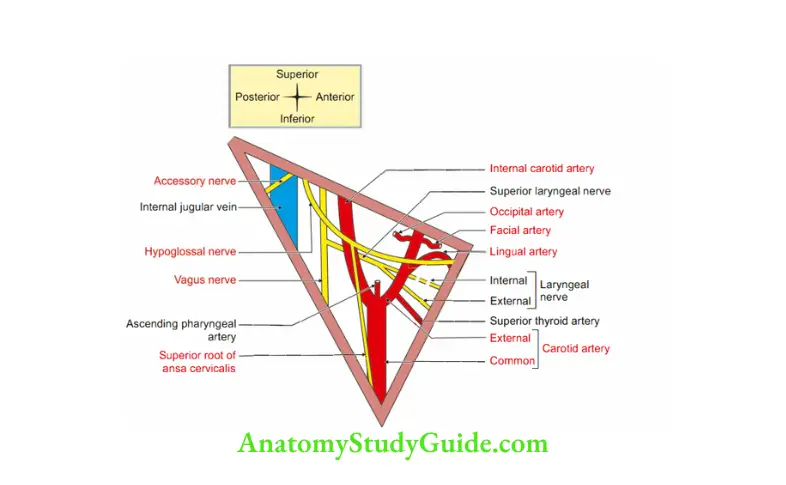
- Lingual artery,
- Facial artery, and
- Occipital artery
3 tributaries of the internal jugular vein
- Pharyngeal vein,
- Lingual vein,
- Common facial vein
2 nerves
- Spinal accessory nerve: It is present at the posterosuperior angle of the triangle It passes superficial to the triangle.
- Hypoglossal nerve: It always crosses the loop of the lingual artery
5 Carotid Triangle Applied anatomy
- A strong carotid pulse is palpable in the carotid triangle inferior to the level of -o
Adam’s apple by gently pressing the common carotid artery against the C’underlying anterior tubercle of the 6th cervical vertebra. - In the elderly, atheromatous plaques may be dislodged by palpations on le tide Hence, pulsation should be felt on the right side since a stroke induced in the right cerebral hemisphere is less devastating.
External Carotid Artery
1 External Carotid Artery Origin: It is one of the terminal branches of the common carotid artery given at the level of superior come of thyroid cartilage.
2 External Carotid Artery Extent: From the upper border of the thyroid cartilage to the neck of the mandible.
3 External Carotid Artery Branches: All the branches of the external carotid artery lie above the level of the angle of the jaw, and hence, supply the face rather than the neck.
The exception is the superior thyroid artery, (which falls down on the job and is afraid of
heights) and reaches down to grab the thyroid
1. Medial: Ascending pharyngeal
2. Dorsal:
- Occipital, and
- Posterior auricular
3. Ventral:
- Superior thyroid,
- Lingual, and
- Facial
4. Terminal:
- Superficial temporal, and
- Maxillary

4 External Carotid Artery Course: It lies anterior and medial to the internal carotid artery at its origin It passes deep to the posterior belly of the digastric and stylohyoid muscle, enters the parotid gland, and divides into terminal branches.
5 External Carotid Artery Relations
1. Superficial
- In the carotid triangle, it is overlapped by the sternomastoid and crossed by the hypoglossal nerve, lingual nerve, and facial vein.
- In the digastric triangle, it is related toposteriorbelly of the digastric and stylohyoid muscle.
- In parotid gland, it overlaps by the retromandibular vein.
2. Deep
- Constrictor muscles of the pharynx.
- Superior laryngeal nerve and its two branches: internal and external laryngeal nerves.
- Internal carotid artery.
Lingual Artery
1 Lingual Artery Origin: It is the 2nd ventral branch of the external carotid artery, which arises opposite to the tip of the greater cornu of the hyoid bone.
2 Lingual Artery Course and Relations: It is divided into three parts by hyoglossus muscle.
- 1st part (lateral to hyoglossus) extends from the origin (external carotid artery) to the tip of the greater cornu of the hyoid bone It forms an upward loop to avoid rupture during the movements of the hyoid bone.
- 2nd part lies deep to the hyoglossus muscle and on the upper border of the greater cornu of the hyoid bone It lies superficial to the middle constrictor.
- 3rd part runs along the anterior border of the hyoglossus muscle It is also called the deep lingual artery
3 Lingual Artery Branches.
- 1st part: Suprahyoid artery
- 2nd part: Dorsal lingual artery
- 3rd part (deep lingual artery): Sublingual artery
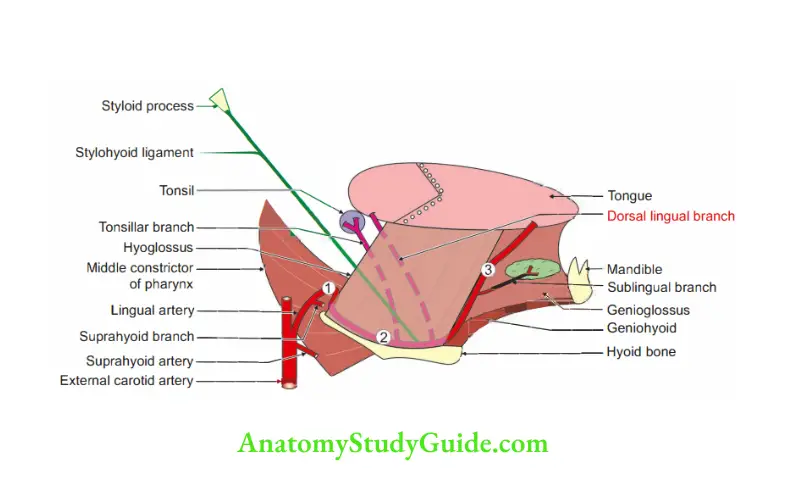
4 Lingual Artery Applied anatomy
- In surgical removal of the tongue, the 1st part of the artery is ligated before it gives
any branch to the tongue or tonsil. - Bleeding from the lingual artery is arrested by pulling the tongue out.
Question 3: Enumerate the branches of Facial Artery in Neck
Answer: 1 Ascending palatine
2 Tonsillar branch
3 Submental
4 Glandular
Question: Why is the Facial Artery Tortuous?
Answer: 1 Facial artery has cervical and facial parts In both segments, the artery is tortuous
2 The cervical part of the facial artery is tortuous to adapt to the movements of the pharynx during deglutition
3 The facial part is tortuous to adapt to the movements of the mandible, lips, and cheek
Facial artery
It is the chief artery of the face
1 Facial Artery Tortuous Peculiarity: The artery is tortuous to avoid rupture during the movements of the pharynx, the contraction of the muscles of the face, and the movements of the temporomandibular joint.
2 Facial Artery Tortuous Origin: It is the 3rd ventral branch of the external carotid artery arising above the level of the tip of the greater cornu of the hyoid bone.
3 Facial Artery Tortuous Course: It is divided into cervical and facial.
- It runs superficial to the superior constrictor of the pharynx and deep to the posterior belly of the digastric and to the ramus of the mandible, at the anterior border of the masseter muscle It grooves the submandibular gland.
- It enters the face by winding around the base of the mandible and pierces deep cervical fascia at the junction of the ramus and body of the mandible.
- It crosses the masseter at an anteroinferior angle It runs upwards half an inch lateral to the angle of the mouth and ascends by the side of the nose and anastomoses with the ophthalmic artery, a branch of the internal carotid artery.
4 Facial Artery Tortuous Branches
A Cervical part
- Ascending palatine,
- Ionsillar,
- Submental, and
- Submandibular
Facial part
- Inferior labial,
- Superior labial, and
- Lateral nasal
5 Applied anatomy: The wounds of the face bleed profusely but heal quickly because
of rich blood supply and profuse anastomosis
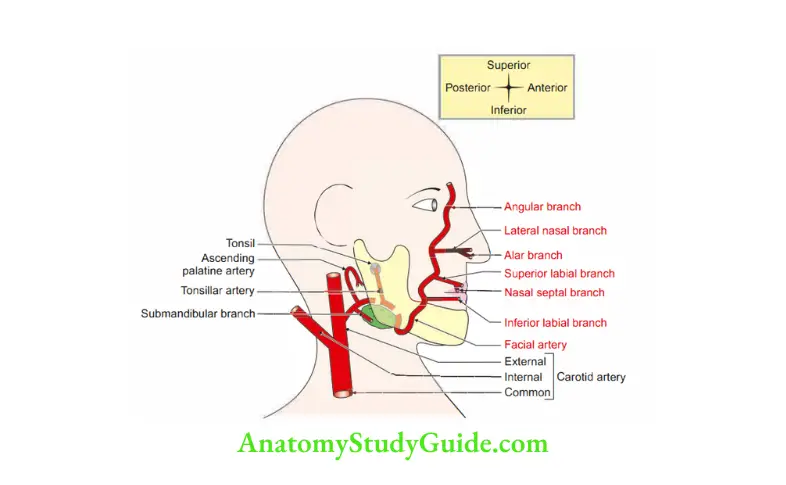
Question 4: Structures passing between external and internal carotid arteries
Answer :1 Muscles
- Styloglossus
- Stylopharyngeus
2 Nerves
- Glossopharyngeal nerve
- The pharyngeal branch of the vagus nerve
3 Bone: Styloid process of the temporal bone
4 Gland: Part of the parotid gland
Sites of anastomosis of external and internal carotid arteries

Ansa cervicalis (ansa hypoglossal)
(Ansa-loop, cervicalis-cervical)
Ansa cervicalis Introduction: A loop formed by ventral rami of cervical nerves.
1 Ansa cervicalis Formation: It is formed by ventral rami of the 1st, 2nd, and 3rd cervical nerves.
2 Ansa cervicalis Roots
- The superior root (descending hyoglossi or anterior root) is formed by the ventral ramus of Cl.
- The inferior root (descending cervicalis or posterior root) is formed by the ventral rami of C2 and C3.
3. Ansa cervicalis Relations: It lies on the anterior wall of the carotid sheath.
4 Ansa cervicalis Distribution
Superior room: Superior belly of omohyoid
Inferior root
- Sternohyoid,
- Sternothyroid, and
- Inferior belly of Omohyoid.
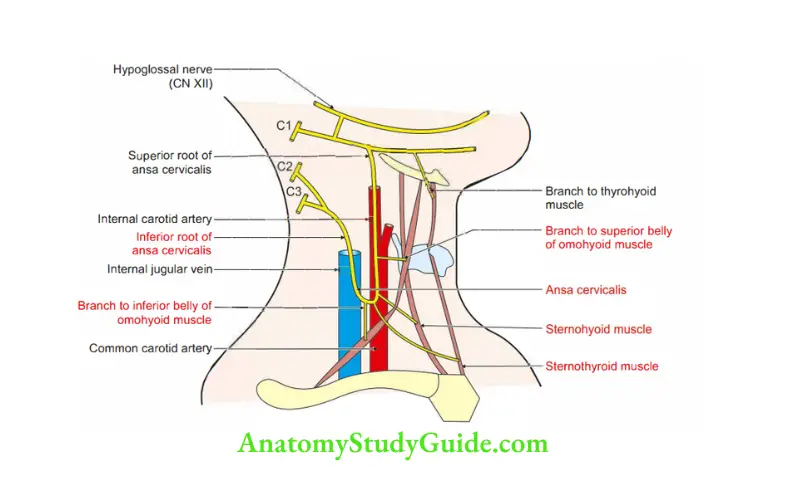
Superior Laryngeal Nerve
1 Superior Laryngeal Nerve Origin: It arises from the inferior ganglion of the vagus
2 Superior Laryngeal Nerve Course:
- It passes downwards and forwards on the superior constrictor of the pharynx Here, it is deep into the internal carotid artery
- It reaches the middle constrictor of the pharynx and divides into branches on thyrohyoid membrane
3. Superior Laryngeal Nerve Branches
1. Internal laryngeal nerve
- It is the larger terminal branch of the superior laryngeal nerve given in the carotid sheath
- It pierces the thyrohyoid membrane and passes deep into it It passes along with
superior laryngeal vessels It is sensory to the mucous membrane of - Posterior one-third of the tongue, and
- Larynx above the vocal fold It includes
- Laryngeal mucous membrane of the laryngeal vestibule,
- Middle laryngeal cavity, and
- Superior surface of the vocal folds
2. External laryngeal nerve
- It is the smaller terminal branch of the superior laryngeal nerve given in the carotid sheath.
- It passes deep to the superior thyroid artery.
- It is a motor branch to the cricothyroid, the only external muscle of the larynx.
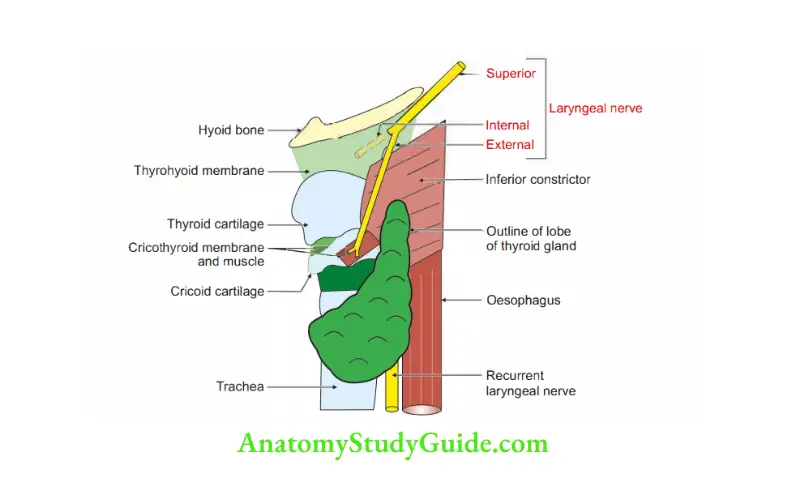
4 Superior Laryngeal Nerve Relations: Superior laryngeal nerve is accompanied by the superior thyroid artery The
external laryngeal nerve has intimate and important relations with branches of
the superior thyroid artery supplying the lateral lobe of the thyroid gland.
External laryngeal nerve and branches of the superior thyroid artery are very close when they are away
from the lateral lobe of the thyroid gland and go apart when they reach the gland
5 Superior Laryngeal Nerve Development: It is the nerve of the IVth pharyngeal arch.
6 Superior Laryngeal Nerve Applied anatomy
- During thyroidectomy, the superior thyroid artery is ligated near the lateral lobe of the gland to avoid damage to the superior laryngeal nerve.
- Damage to the internal laryngeal nerve causes anesthesia of the superior laryngeal mucosa It results in loss of the protective mechanism of the larynx Thus, foreign bodies can easily enter the larynx.
- Injury to the external laryngeal nerve results in paralysis of the cricothyroid muscle It is unable to vary the length and tension of vocal cords It manifests as a monotonous voice It goes unnoticed in persons who do not use a wide range of tones in their speech It is critical to singers and public speakers.
- A superior laryngeal nerve block is used with end tracheal intubation in conscious patients.
Question 5: What is the effect of pressure damage on the internal laryngeal nerve, external laryngeal nerve, and recurrent laryngeal nerve?
Answer :1 Pressure on the internal laryngeal nerve causes loss of sensation of the larynx above the
vocal cords on the affected side.
2 Pressure on the external laryngeal nerve causes paralysis of the cricothyroid muscle It leads to weakness of phonation due to the loss of the tightening effect of the cricothyroid muscle.
3 Pressure on the recurrent laryngeal nerve causes a change in the voice.
- Unilateral pressure does not cause complete loss of speech.
- Bilateral pressure causes remarkable loss of speech.
Anterior Jugular Vein
1 Anterior Jugular Vein Origin: Begins in the submental region.
2 Anterior Jugular Vein Course: It runs in the superficial fascia 1cm lateral to the median plane in the anterior triangle of the neck It enters the suprasternal space by piercing the investing layer of deep cervical fascia.
It joins with its fellow of the opposite side by a transverse channel, the jugular venous arch, and then runs deep to the sternocleidomastoid
3 Anterior Jugular Vein Termination: It opens into the external jugular vein.
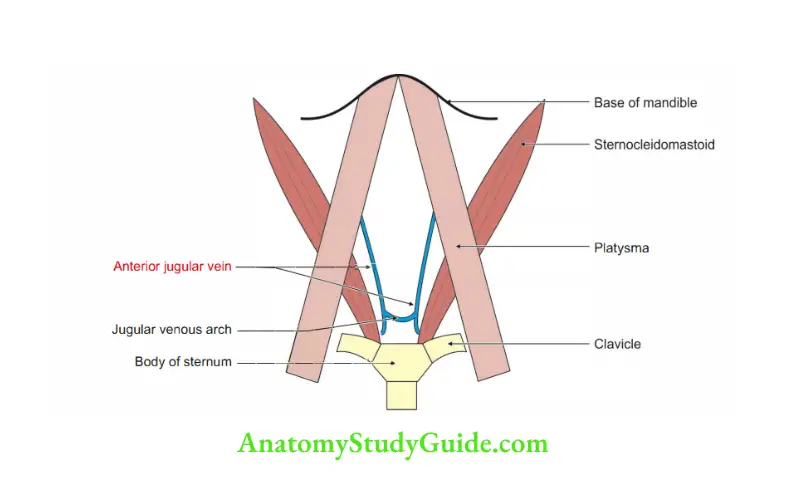
4 Anterior Jugular Vein Applied Anatomy: It is one of the contents of suprastemal space Injury to the vein results in air embolism.
Leave a Reply